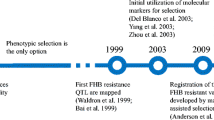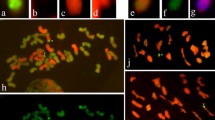Abstract
Fusarium head blight (FHB), caused primarily by Fusarium graminearum, is a major disease problem in wheat (Triticum aestivum). Genetic engineering holds significant potential to enhance FHB resistance in wheat. Due to the requirement of screening for FHB resistance on flowers at anthesis, the number of screens carried out in a year is limited. Our objective was to evaluate the feasibility of using the rapid-maturing dwarf wheat cultivar Apogee as an alternative genotype for transgenic FHB resistance research. Our transformation efficiency (number of transgenic plants/number of embryos) for Apogee was 1.33%. Apogee was also found to exhibit high FHB susceptibility and reached anthesis within 4 weeks. Interestingly, microsatellite marker haplotype analysis of the chromosome 3BS FHB resistant quantitative trait locus (QTL) region indicated that this region maybe deleted in Apogee. Our results indicate that Apogee is particularly well suited for accelerating transgenic FHB resistance research and transgenic wheat research in general.




Similar content being viewed by others
Abbreviations
- FHB:
-
Fusarium head blight
- 2,4-D:
-
2,4-diclorophenoxyacetic acid
- GUS:
-
β-glucuronidase
- QTL:
-
quantitative trait locus
References
Anand A, Zhou T, Trick HN, Gill BS, Bockus WW, Muthukrishnan S (2003) Greenhouse and field testing of transgenic wheat plants stably expressing genes for thaumatin-like protein, chitinase and glucanase against Fusarium graminearum. J Exp Bot 54:1101–1111
Anderson JA, Stack RW, Liu S, Waldron BL, Fjeld AD, Coyne C, Moreno-Sevilla B, Fetch JM, Song QJ, Cregan PB, Frohberg RC (2001) DNA markers for Fusarium head blight resistance QTLs in two wheat populations. Theor Appl Genet 102:1164–1168
Bai GH, Shaner G (1994) Scab of wheat: Prospect for control. Plant Dis 78:760–766
Becker D, Brettschneider R, Lorz H (1994) Fertile transgenic wheat from microprojectile bombardment of scutellar tissue. Plant J 5:299–307
Bugbee B, Koerner G, Albrechtsen R, Dewey W, Clawson S (1997) Registration of cultivars. Crop Sci 37:626
Campbell BT, Baenziger PS, Sato AMS, Clemente T (2000) Inheritance of multiple transgenes in wheat. Crop Sci 40:1133–1141
Chen WP, Chen PD, Liu DJ, Kynast R, Friebe B, Velazhahan R, Muthukrishnan S, Gill BS (1999) Development of wheat scab symptoms is delayed in transgenic wheat plants that constitutively express a rice thaumatin-like protein gene. Theor Appl Genet 99:755–760
Cheng M, Fry JE, Pang S, Zhou H, Hironaka CM, Duncan DR, Conner TW, Wan Y (1997) Genetic transformation of wheat mediated by Agrobacterium tumefaciens. Plant Physiol 115:971–980
Christensen AH, Sharrock RA, Quail PH (1992) Maize polyubiquitin genes: structure, thermal perturbation of expression and transcript splicing, and promoter activity following transfer to protoplasts by electroporation. Plant Mol Biol 18:675–689
de la Peña RC, Smith K, Capettini F, Muehlbauer GJ, Gallo-Meagher M, Dill-Macky R, Somers DA, Rasmusson DC (1999) Quantitative trait loci associated with resistance to fusarium head blight and kernel discoloration in barley. Theor Appl Genet 99:561–569
Hu T, Metz S, Chay C, Zhou HP, Biest N, Chen G, Cheng M, Feng X, Radionenko M, Lu F, Fry J (2003) Agrobacterium-mediated large-scale transformation of wheat (Triticum aestivum L.) using glyphosate selection. Plant Cell Rep 2:1010–1019
Jefferson RA, Kavanagh TA, Bevan MW (1987) GUS fusions: beta-glucuronidase as a sensitive and versatile gene fusion marker in higher plants. EMBO J 6:3901–3907
Kolb FL, Bai G-H, Muehlbauer GJ, Anderson JA, Smith KP, Fedak G (2001) Host plant resistance genes for Fusarium head blight: mapping and manipulation with molecular markers. Crop Sci 41:611–619
McMullen M, Jones R, Gellenberg D (1997) Scab of wheat and barley: A re-emerging disease of devastating impact. Plant Dis 81:1340–1348
Murashige T, Skoog FA (1962) A revised medium for rapid growth and bioassays with tobacco tissue cultures. Plant Physiol 15:473–497
Nehra NS, Chibbar RN, Leung N, Caswell K, Mallard C, Steinhauer L, Baga M, Kartha KK (1994) Self-fertile transgenic wheat plants regenerated from isolated scutellar tissues following microprojectile bombardment with two distinct gene constructs. Plant J 5:285–297
Nganje WE, Katiebie S, Wilson WW, Leistritz FL, Bangsund DA (2004) Economic impacts of Fusarium Head Blight in wheat and barley: 1993–2001. North Dakota State University Agribusiness and Applied Economics Report 538. 53 pp
Okubara PA, Blechl AE, McCormick SP, Alexander NJ, Dill-Macky R, Hohn TM (2002) Engineering deoxynivalenol metabolism in wheat through the expression of a fungal trichothecene acetyltransferase gene. Theor Appl Genet 106:74–83
Parry DW, Jenkinson P, Mcleod L (1995) Fusarium ear blight (scab) in small grain cereals—a review. Plant Path 44:207–238
Rasco-Gaunt S, Riley A, Cannell M, Barcelo P, Lazzeri PA (2001) Procedures allowing the transformation of a range of European elite wheat (Triticum aestivum L.) varieties via particle bombardment. J Exp Bot 52:865–874
Riede CR, Anderson JA (1996) Linkage of RFLP markers to an aluminum tolerance gene in wheat. Crop Sci 36:905–909
Rudd JC, Horsley RD, McKendry AL, Elias EM (2001) Host plant resistance genes for Fusarium head blight: sources mechanisms, and utility in conventional breeding systems. Crop Sci 41:620–627
Song QJ, Shi JR, Singh S, Fickus EW, Costa JM, Lewis J, Gill BS, Ward R, Cregan PB (2005) Development and mapping of microsatellite (SSR) markers in wheat. Theor Appl Genet 110:550–560
Srivastava V, Anderson OD, Ow DW (1999) Single-copy transgenic wheat generated through the resolution of complex integration patterns. Proc Natl Acad Sci USA 96:11117–11121
Sutton JC (1982) Epidemiology of wheat head blight and maize ear rot caused by Fusarium graminearum. Trans Br Mycol Soc 70:187–192
Tuite J, Shaner G, Everson RJ (1990) Wheat scab in soft red winter wheat in Indiana in 1986 and its relation to quality measurements. Plant Dis 74:959–962
Vasil V, Castillo AM, Fromm ME, Vasil IK (1992) Herbicide resistant fertile transgenic wheat plants obtained by microprojectile bombardment of regenerable embryogenic callus. Bio/Technology 10:667–674
Veillard PV, Kokini JL (2001) Evaluation of the Apogee wheat variety for its utilization in baked products and pasta. 17th American Society for Gravitational and Space Biology Meeting, Alexandria, VA. 2001. Abstract 94
Waldron BL, Moreno-Sevilla B, Anderson JA, Stack RW, Frohberg RC (1999) RFLP mapping of a QTL for Fusarium head blight resistance in wheat. Crop Sci 39:805–811
Weeks JT, Anderson OD, Blechl AE (1993) Rapid production of multiple independent lines of fertile transgenic wheat (Triticum aestivum). Plant Physiol 102:1077–1084
Acknowledgements
We thank Drs. Howard Rines and Ruth Dill-Macky for critical review of the manuscript. We are most grateful to Dr. Tom Clemente and Shirley Sato of the University of Nebraska for their advice and assistance in generating the transgenic wheat plants. We thank Dr. Peter Quail of the Plant Gene Expression Center, UC-Berkeley for his kind gift of the pAHC25 plasmid. We also thank Dr. Ruth Dill-Macky for her generous gift of F. graminearum inoculum. The authors thank Zachary Blankenheim and Joel Mason (USDA-ARS Plant Science Research Unit, St. Paul, MN) for their assistance in plant care and obtaining FHB and comparative growth data. We are most grateful to the USWBSI and the Minnesota Small Grains Initiative for funding.
Author information
Authors and Affiliations
Corresponding author
Additional information
Communicated by M. C. Jordan
C.A. Mackintosh and D.F. Garvin contributed equally to the article and should be considered co-first authors
Rights and permissions
About this article
Cite this article
Mackintosh, C.A., Garvin, D.F., Radmer, L.E. et al. A model wheat cultivar for transformation to improve resistance to Fusarium Head Blight. Plant Cell Rep 25, 313–319 (2006). https://doi.org/10.1007/s00299-005-0059-4
Received:
Revised:
Accepted:
Published:
Issue Date:
DOI: https://doi.org/10.1007/s00299-005-0059-4




